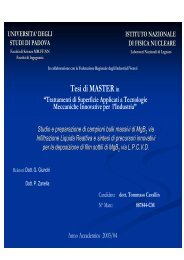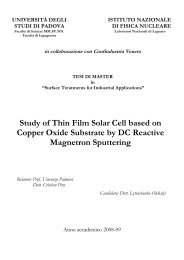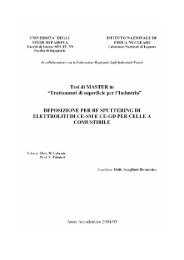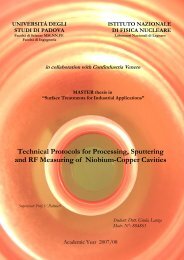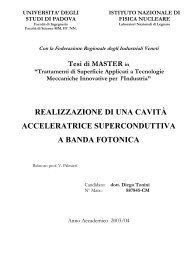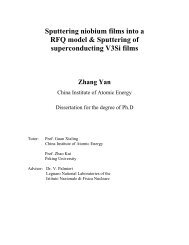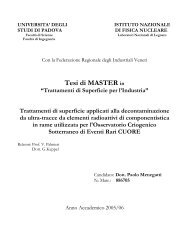Magnetron sputtering of Superconducting Multilayer Nb3Sn Thin Film
Magnetron sputtering of Superconducting Multilayer Nb3Sn Thin Film
Magnetron sputtering of Superconducting Multilayer Nb3Sn Thin Film
Create successful ePaper yourself
Turn your PDF publications into a flip-book with our unique Google optimized e-Paper software.
Unfortunately even if no grain boundaries are present and a δ-phase singlecrystal is considered the single grain resistivity is not so low: A minimum value <strong>of</strong>ρ n = 30μΩcm is expected, due to both metallic and gaseous vacancies in thelattice. This problem that is common to all the other B1 compounds consists in thefact that what corresponds to the equiatomic composition is not the formulaNb 1.0 N 1.0 , but Nb 0.987 N 0.987 : vacancies randomly distributed in both sublatticesamounts to 1.3% respectively.In order to improve the performance <strong>of</strong> NbN, the Titanium is added into. Itpresents all the advantages <strong>of</strong> the NbN, in the meanwhile it shows electricalconduction properties as more metallic as higher the titanium percentages is.Titanium is a good Nitrogen getter and the more Titanium we have the lowerlattice vacancies will be. The Nitrogen stoichiometry hence is closer to 1 than forNbN. Moreover the critical temperature is even higher than that <strong>of</strong> NbN forTitanium content up to 40%. The resistivity instead decreases steeply versus theTitanium content [15-17] . This last phenomenon is the main reason under NbTiNchoice. NbTiN cavities have been sputtered at CERN and at Saclay. The Q 0 , atzero field, is higher than the Q-value <strong>of</strong> Niobium cavities, but the acceleratingfield achieved does not overcome the 10 Mv/m limit [18] .V 3 GaThe A15 phase forms by a congruent reaction from the bcc solid solution at1295°C and is stable from 20 at. % to 32 at. % gallium. The T C shows a markedmaximum <strong>of</strong> 15.9K at stoichiometry and decreases almost linearly on both sizes.V 3 Ga has the highest electronic density <strong>of</strong> states <strong>of</strong> all known A15 compounds. Incontrast to the latter, however, it does not exhibit a low temperature phasetransformation, which is explained by the fact that perfect ordering in thiscompound cannot be reached.V 3 AlIt shows a T C up to 14K, but it is a metastable compound, superconductingonly under thin film form. In principle metastability would be not a problem forRF applications construction, if V-Al is sputtered into a resonator, and moreover ithas the advantage <strong>of</strong> a relatively low temperature <strong>of</strong> deposition. It should deservefurther investigation, being a relatively little studied compound. The real problemindeed is that, because <strong>of</strong> metastability, this compound is not applicable to12



